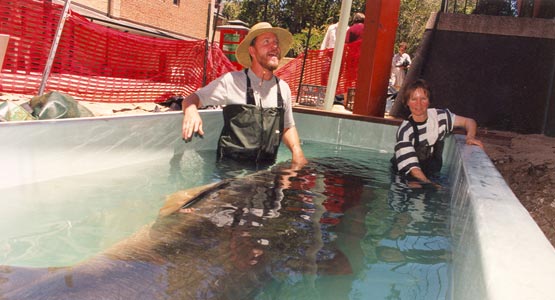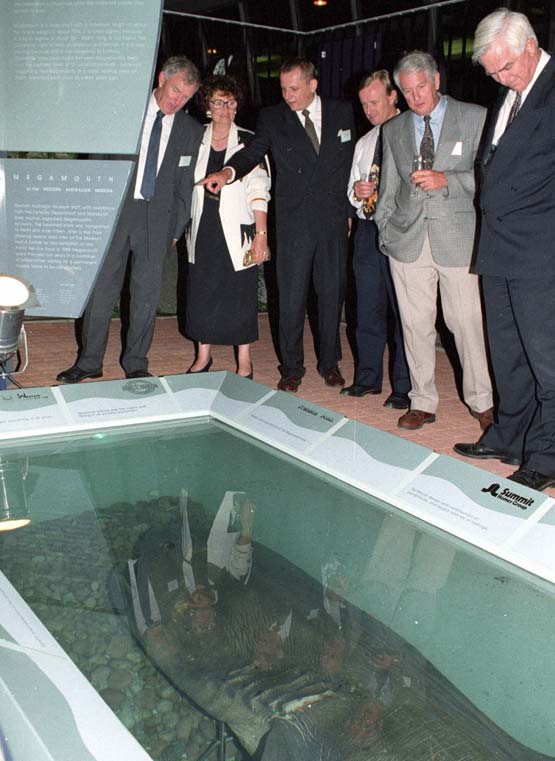Beached to Tanked
In August, 1988, several surfers saw what looked like a whale intent upon beaching itself off the coast of Mandurah, south of Perth. Despite their attempts to coax the animal into deeper water, by the following morning it lay dead upon the beach. However this was no ordinary beaching.
Derek Blackman (Fisheries WA) alerted the Museum to its presence as it was unlike anything he had seen before, an animal with features that seemed to be a cross between a whale and a shark.
What had been discovered was an extremely rare shark; only the third example of a Megamouth specimen found in the world. The first of its kind was seen as being so unusual it was placed in a new family of sharks, the megachasmidae.

- Putting Megamouth III on display
- Photo by WA Museum
- Photo copyright of WA Museum
The Mandurah Shire Council helped workers move the 700kg specimen onto a truck with the use of a front end loader. After being relocated to Perth, Megamouth was placed in a freezer before being viewed by 4,000 people over the weekend. It was initially preserved in formalin.
Due to its biological and scientific importance, since the acquisition of Megamouth in 1988 the Museum has devoted much time to its protection. Since 1893, formaldehyde has been used to stop the decay of organic tissue. Usually, the Museum's method of preservation involves taking the animal apart and burying the flesh in sand mounds for 18-24 months before washing the material and re-assembling the body using wires. However, due to Megamouth's size, the decision was made to use a needle to directly inject 40 litres of formaldehyde into its body.
Before it was put on display, the shark was opened under the abdomen and the viscera (organs) were removed. The amount of tissue that was taken out amounted to approximately 60kg of liver and intestines. If these had remained in the shark it is likely the tank solution would be obscured with fat and oils.
After this, it was placed in a treatment tank where the chemical was allowed to diffuse into the body.

- Megamouth III trustees looking on
- Photo by WA Museum
- Photo copyright of WA Museum
Megamouth remained preserved in this manner for the next 13 years. However, formaldehyde is both carcinogenic and highly explosive, and is a danger to staff who handle high levels of it. Therefore, there was a desire to develop methods of preservation that would reduce the amount of formaldehyde used. This chemical has also caused the specimen to shrivel and given it the wrinkled appearance present while on display in Perth.
Museum staff decided to remove the formaldehyde and replace this with glycerol. This will cause a swelling of the tissue and restore the appearance of the specimen.
Methods of formaldehyde extraction involve washing specimens in water and allowing the chemical to diffuse out of the shark. This process, if carried out for long enough, removes nearly all of the chemical initially added. Megamouth was washed in several thousand litres of water in a treatment tank from the 30th of November 1994 to the 3rd of January 1995. After the washing the water in the tank was removed and replaced with ethanol.
In September 2010 Megamouth was moved to Fremantle into a new custom-built tank where more conservation work will be undertaken to restore its colour and condition, and to ensure that this specimen of inestimable can be preserved for the future.
Some facts about our Megamouth
- Megamouth III the 5.2m, 700kg shark was discovered in August 1988.
- Derek Blackman described that, "the creature had the fins and gill slits normally expected of a shark, but a short, almost puglike snout that gave it the appearance of a baby whale".
- The shark's most distinctive features include its exceptionally wide mouth for feeding on plankton and a bathtub-shaped lower jaw for gulping in large volumes of water.
- The shark kept by the WA Museum is Megamouth III. The Roman numeral suffix indicates the chronological order in which the specimens were found. This kind of nomenclature is extremely rare, and is used only due to the significance of the specimens.
- Immediately after being found the shark was transported to a deep freezer in Perth. That weekend it was viewed by over 4,000 people before being preserved in formalin.